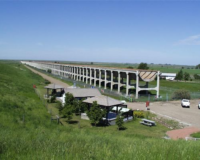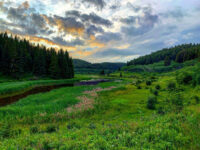Being active in nature is good for your brain
By Submitted Article on June 26, 2020.
Desirea Agar
ALBERTA HEALTH SERVICES
Spending time outdoors, whether it be in a green space near your house or immersed in a forest, benefits your overall well-being! Add in some imaginative play with your kids or take a walk or jog in that green space and you’ll receive a complete well-being boost.
There is a growing amount of evidence suggesting the link between positive mental health and access to green spaces. You can get these benefits simply by sitting near a tree, on a grassy field or walking down a path. By being in nature you will feel better; have increased energy and decreased anxiety, fatigue and sadness. What’s fascinating about this is that researchers have found that stress levels are inversely related to the amount of time spent in green spaces. This means that it’s not just natural forests that offer these benefits, but also your own urban school-yard green spaces. Because of all of this, spending time in nature makes you more resilient.
Resiliency is something we all need in order to handle the ups and downs of life. For children, resiliency can also be fostered by engaging in unstructured free play. Through this type of play children get to practise skills they will need to be successful as adults; skills such as perspective taking, problem solving, active listening and empathy. When children engage in this type of play in nature, they get to take healthy risks, like climbing a tree, balancing on a log or hopping across a stream. Risky play is the foundation to physical literacy and being active for life. As the 2015 ParticipACTION report card states, “Access to active play in nature and outdoors – with its risks – is essential for healthy child development. We recommend increasing children’s opportunities for self-directed play outdoors in all settings – at home, at school, in child care, the community and nature.”
What’s more, spending time nature results in increased physical activity for children and adults as well. Increased physical activity is beneficial to folks of all ages, but not just for the physical aspects. Physical activity also benefits our mental health. When we are physically active our bodies release feel-good hormones such as dopamine, serotonin, oxytocin and endorphins. What’s more, getting frequent physical activity also helps us to self-regulate in times of stress.
So, physical activity improves our physical health and our mental health. But, did you know it also supports overall brain health? The 2018 ParticipACTION Report Card on Physical Activity for Children and Youth produced an expert statement on the link between physical activity and brain health:
“For better brain health, all children and youth should be physically active on a regular basis. In addition to physical health benefits, physical activity also improves cognition, brain function and mental healthÉ Many of the brain processes that make for better, more efficient learners – such as focus, memory, and recall – are enhanced after single or repeated bouts of physical activity. Overall, active children and youth make for better- achieving students.”
These brain-boosting benefits are available to people of all ages. With our society having shifted to a more sedentary, screen-driven lifestyle, we are missing some of these key benefits. Simple changes that can go a very long way. Simply go outside in nature and take a walk; your brain will thank you!
Need some inspiration? Here are a few things you can do as a family:
– Go for a walk. Set a timer to see how far you can walk in five minutes, 10, 20 or 30.
– Blow bubbles and try to pop them.
– Plan a nature scavenger hunt. Look for pine cones, acorns and other common outdoor items and tally who found the most pieces.
– Play Follow the Leader through your yard or neighbourhood.
– Create a sidewalk chalk hopscotch.
– Climb a tree.
– Have a picnic at a local park, beach or your own backyard.
– Do things you’d normally do inside, like play board games or have a pillow fight.
– Go for a group jog/bike ride.
– Take turns playing photographer with your phone or camera.
– Make mud pies. Who can make the fanciest creation?
– Race sticks, leaves, etc. down a creek.
– Build paper airplanes. Who can make theirs fly the farthest?
– Search for bugs.
– Run through the sprinkler.
– Make homemade bird feeders out of pine cones, peanut butter and birdseed.
– Look for things like pine cones, sticks, shells and rocks to make a mobile.
– Make a rock, stick, pine cone mandala.
– Find shapes in the clouds.
– Paint rocks.
– Build a stick fort.
Desirea Agar is a Health Promotions Facilitator with Alberta Health Services. She can be reached via email, desirea.agar@ahs.ca.
34-33




